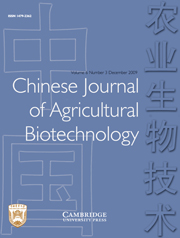No CrossRef data available.
Article contents
Identification of resistance to corn-borer of transgenic maize inbred lines and hybrids with GFM Cry1A gene
Published online by Cambridge University Press: 30 October 2009
Abstract
Six transgenic maize lines with the fully modified gene GFM Cry1A were obtained and polymerase chain reaction (PCR) analysis of their T5 generation plants indicated that foreign genes could be stably inherited. Three hybrids (Simi25Bt, Tongdan24Bt and Jidan209Bt) were created using the transgenic lines and combined with regular maize inbred lines. The results of resistance identification of the transgenic inbred lines and hybrids showed that the difference of resistance among transgenic lines was very significant; there also existed a difference among individuals of the same line and among the three hybrids. Compared with the control inbred line (CK), the average of four transgenic inbred lines in the number of tunnels per stalk, larval tunnel length per plant and length of surviving larvae were decreased by 70%, 80% and 70%, respectively. Enzyme-linked immunosorbent assay (ELISA) testing showed that the average of Bt Cry1A protein expression level for six transgenic inbred lines was 0.16% total protein and the highest expression level was 0.19%. At maturity, compared with the control variety (CK), the larval tunnel length per plant of the three hybrids (Simi25Bt, Tongdan24Bt and Jidan209Bt) was decreased by 39.97%, 36.20% and 53.83%, respectively, which was a decrease of 43.36% on average. The investigation of agronomic characters showed that there was no significant difference between the improved hybrids and the control in plant height, ear length, row number per ear, kernel number per row and 100-kernels weight. It is thought that the GFM Cry1A gene can be applied to improve resistance to corn-borer, and maize inbred lines with the Bt gene can be directly applied to conventional maize breeding.
Keywords
- Type
- Research Papers
- Information
- Copyright
- Copyright © China Agricultural University 2009


